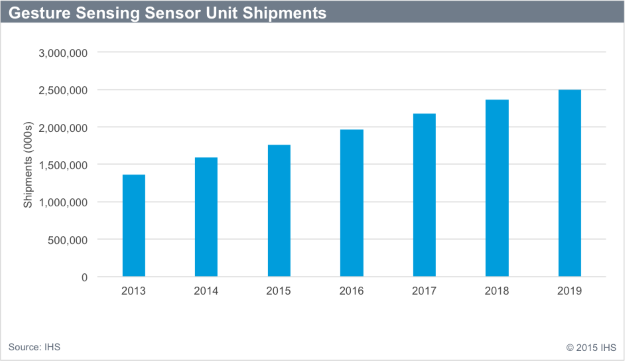With emerging virtual reality games, smartwatches, smart TVs and other consumer electronics and information technology (IT) applications entering the market, shipments of gesture sensing control user interfaces are poised to grow 10% year over year, to reach 1.8 billion units in 2015. While touch-screen technology works well in smartphones, tablets and other mobile devices with flat panel displays, it is less suitable for use in some new and emerging applications; therefore, gesture sensing control will fill an industry need gap, according to IHS, the leading global source of critical information and insight.
“Gesture sensing control will not compete with touch screens, but will instead be complementary, because each technology is appropriate for specific applications,” said Calvin Hsieh, director for touch and user interfaces for IHS. “Smart TVs, for example, are not good candidates for touch screens, because they are too far from viewers. On the other hand, gesture sensing control is especially suitable for future immersive augmented reality and virtual reality computing.”

The Rise of Gesture Sensing Technologies
Optical-based three-dimensional (3D) depth sensing technologies — such as time of flight (ToF), stereo vision and structured light for freehand gesture sensing control — will account for two thirds (66%) of sensor unit shipments for game console applications in 2015; as the use of controller-based sensors becomes more common.
Due to Intel’s promoting RealSense, gesture-sensing control with 3D depth-sensing ability is expected to grow 43% in 2015, year over year, overtaking two-dimensional (2D) webcam technology, in notebook PC applications in 2015. Apple TV will also likely adopt the structured light technology Apple acquired from PrimeSense, which would lead to 35% year-over-year growth in gesture sensing control for smart TV applications.
“Mainstream consumers have been aware of gesture sensing control, since the debut of the Nintendo Wii in 2006,” Hsieh said. “Now almost a decade later, gesture sensing control is poised to become the second most common user interface for smart devices after touch screens. It will take time, however, to develop even more creative and useful apps that rely on gesture sensing, and change users’ in-grained, touch-screen-centric behaviors.”
For information about purchasing the IHS Gesture Sensing Control for Smart Devices report, contact the sales department at IHS in the Americas at +1-844-301-7334 or
Advertisement
Learn more about IHS iSuppli





